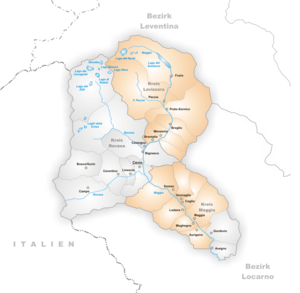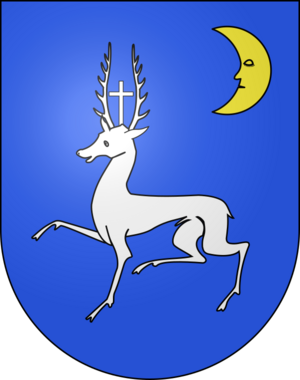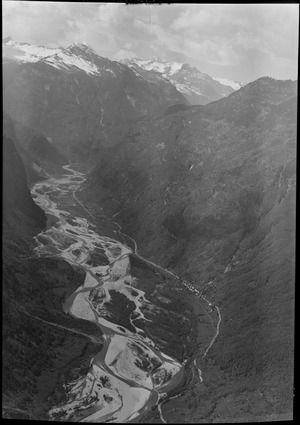Someo facts for kids
Someo is a small village located in the Vallemaggia area of Ticino, Switzerland. It used to be its own municipality, but in 2004, it joined the larger nearby municipality of Maggia.
Contents
Someo's Population and Size
In 2003, Someo had 258 people living there. The area of the municipality was about 32.73 square kilometers (about 12.6 square miles).
Why People Left Someo
In the 1800s, many people from Someo moved to other countries like France, England, California, and Australia. For example, Antonio Tognazzini founded a town called Someo (now Casmalia) in California to honor his family's original village.
Many people from certain parts of Switzerland, especially Ticino, Fribourg, and Valais, often looked for new chances abroad.
Swiss People Moving to Other Countries
People from the Italian-speaking part of Switzerland often had to move because there weren't enough jobs or resources to support everyone in their local area.
Most of this movement was for a short time, like working in Milan or other Italian cities during the summer and returning home for winter. As travel became easier, people from Ticino started going to France, England, the Netherlands, and other countries in Western Europe. They often stayed longer, sometimes even permanently.
Ticinese Workers in Europe
For many centuries, Italy was the main place people went for seasonal work. For longer stays, they went to France, England, and other European countries.
Many Ticinese worked in construction. They were masons (stone workers), stonecutters, site managers, stucco workers, and sculptors. During the Middle Age, the Comacine masters were famous artists from Ticino and Lombardy. Later, architects like Domenico Fontana, Carlo Maderno, and Francesco Borromini worked in big Italian cities like Rome and Florence. Even later, architects such as Domenico Trezzini built churches and buildings in Russia.
People from the Blenio Valley became chocolate makers in Milan, roasted chestnuts in cities like Lyon and Paris, and ran restaurants in London.
Ticinese people abroad also worked as porters, waiters, coppersmiths (from Valcolla), knife-grinders, glaziers (from Claro), brick-makers, and chimney sweeps. Young boys from Onsernone were sometimes sent up chimneys to clean them.
In the early 1800s, about ten thousand Ticinese lived in Italy, and more than ten thousand moved to other European countries each year. By 1858, nearly eight thousand Ticinese were registered at the Swiss embassy in Paris.
In 1853, General Joseph Radetzky, who was in charge of Lombardy-Venetia, ordered all Ticinese people to leave and closed the border with Ticino. More than six thousand Ticinese were sent back. This caused a big economic problem for Ticino because they couldn't get wheat from Italy and had to feed all these people. The order was canceled two years later.
Moving to California
Many Ticinese people moved to California in the 1800s, especially during the California Gold Rush. The first two migrants arrived in San Francisco in 1849. Over the next few years, hundreds more followed, mostly from the northern valleys like Valle Maggia and Valle Leventina.
Often, their local village or community helped them pay for the trip. They might mortgage their property or get private loans. Travel agencies arranged the journey, which often involved crossing the Gotthard Pass on foot and taking a train from Lucerne.
They usually sailed from ports like Le Havre, Hambourg, or Antwerp. Sometimes, migrants worked in London first to save money for the trip to California.
The journey by ship took several months because they had to sail all the way around South America. Another option was to get off the ship in Colón and cross the Isthmus of Panama. The trip from New York City to San Francisco became much faster after the First transcontinental railroad opened in 1869.
Reasons for Moving to California
Many things influenced how many people moved. For example, when General Radetzky closed the border, more people decided to emigrate.
Reasons for leaving (push factors) included:
- More people living in the area.
- Crop failures.
- Floods and landslides.
- Political problems.
Reasons for moving to California (pull factors) included:
- The gold rush.
- Available farmland.
- Jobs that paid well.
- Cheaper travel costs.
However, the American Civil War and economic downturns reduced the number of migrants.
One researcher found 882 Ticinese in California in 1870, but the real number was likely much higher. By 1930, about twenty thousand Swiss Americans were of Ticino descent. This number doesn't include those who returned home before 1930.
Life in California
Most Ticinese became dairy farmers. Their letters home described their hard work, like milking about twenty cows by hand. Their farms were much larger than the pastures they knew in Switzerland. In winter, they often worked in sawmills or factories.
Many started as milkers, saved money, and then bought their own small farms with bank loans. A Swiss American bank was even founded in Locarno with branches in San Francisco and San Luis Obispo. This bank allowed emigrants to save money and send it back to Ticino.
While some Ticinese were miners, most preferred farm work because that's what they knew best. Others became winemakers, gardeners, carpenters, storekeepers, hotel owners, and bakers.
In San Francisco, the Ticinese created groups to help each other and a newspaper in Italian with news from Ticino and their new community.
After World War II, people stopped moving from Ticino to the United States. The second generation (children of the migrants) quickly became part of American society. They stopped speaking the Ticinese or Italian, and family connections became harder to keep. Today, their descendants live all over the United States. You can still find their family names, street names, and tombstones in Catholic cemeteries as reminders of their Ticinese heritage.
One negative effect for the villages in Valle Maggia was that most emigrants were men, which caused an imbalance in the population. Many women had to take on jobs traditionally done by men, and some difficult pastures were abandoned. However, money sent home by emigrants helped repair buildings and churches. Stories of a "rich uncle in America" are common in Ticino.
Moving to Australia
The gold rush in Victoria began in 1851. Thousands of gold seekers, including Europeans and Chinese, went to Australia to dig for gold.
Miners had to pay for a license in advance. This caused problems between the miners and the authorities, leading to a rebellion where over 30 people died.
Some of the first Ticinese gold diggers became rich and encouraged others to come to Australia. The journey was dangerous and could take up to five months. Emigrants often had to mortgage their property or get a private loan. Travel agencies arranged the trip, but some migrants were cheated by dishonest agencies. In 1874, Switzerland passed a law to regulate these agencies.
Working in the gold fields was very hard and risky. Diggers worked from morning until night, and there was no guarantee of finding gold. Many people felt discouraged, and most returned poorer than before. In 1863, the representative for the Lugano District in Ticino advised people not to move to Australia.
Between 1850 and 1860, about 2,300 Ticinese moved to Australia. Most came from northern Ticino, especially the Valle Maggia. About a third of them stayed in Australia, working as farmers, grape growers, merchants, and hotel owners. Those who stayed in the gold fields often ended up working for mining companies in low-paying, insecure jobs.
The second generation of Ticinese in Australia also became part of Australian society. They stopped speaking the Ticinese or Italian, and family ties became weaker. Connections with Ticino were mostly limited to short visits during European vacations. Family names and some tombstones in Catholic cemeteries are the current signs of emigration from Ticino.
People of Italian and Italian-speaking Swiss descent in Australia gather every year in Hepburn Springs for the Swiss Italian Fiesta.
Moving to Argentina
Many Ticinese, especially from southern Ticino, helped settle Argentina and other South American countries. The journey to Buenos Aires by sailing ship took three months. Later, steamboats made the trip much shorter (one month) and safer.
Switzerland and some Swiss municipalities encouraged people to move to South America. A federal office helped with emigration issues. Until 1937, financial aid was given to those settling in Argentina. A Swiss Consul in Le Havre also advised migrants. Some migrants needed protection from untrustworthy travel agencies.
Argentina opened a consulate in Bellinzona to encourage immigration, but civil wars and political takeovers made it difficult to promote.
The number of immigrants grew quickly in the late 1800s. However, living conditions were tough due to epidemics (like yellow fever in 1871 and cholera in 1874), political instability, civil wars, and money losing its value.
Most Ticinese lived in cities. Swiss farming communities were mainly founded by people from Fribourg and Valais. An attempt to create a farming community in Paraguay by Mosé Bertoni was an interesting scientific experiment but failed financially.
Ticinese Occupations in Argentina
In construction, Ticinese people worked as masons, stonecutters, site managers, carpenters, architects, stucco workers, and sculptors. Among business people, they were bankers, hotel owners, industrialists, engineers, doctors, pharmacists, lawyers, and teachers. Other common jobs for Ticinese abroad were also found in Argentina: dairy farmers, porters, waiters, coppersmiths, knife-grinders, glaziers, brick-makers, and chimney sweeps.
Mutual aid societies and patriotic groups were formed to strengthen connections among fellow countrymen. For example, the Swiss Philanthropic Society of Buenos Aires, founded in 1861, had 190 members and helped many sick and poor Ticinese.
A book by Pedrazzini describes the professional and political activities of many Ticinese who moved to Argentina. Families like the Bernasconi, Chiesa, de Marchi, Matti, Pellegrini, Quadri, and Soldati played important roles in Argentina's economy and politics. Villa Lugano, now a working-class area in Buenos Aires, was once a town founded by Giuseppe (José) Soldati to honor Lugano, his home city in Switzerland.
The most famous Ticinese migrant is the poet Alfonsina Storni. She was four years old when her parents moved to Argentina. Her father opened a brewery in San Juan and later a restaurant in Rosario.
From 1869 to 1892, hundreds of people left Ticino for South America. Pedrazzini's book lists the names and home villages of 6,470 migrants from Ticino. An old president of the Swiss Philanthropic Society of Buenos Aires estimated that migration was profitable for 10% of his countrymen, made no difference for 50%, and was negative for 40%.
Wealthy migrants who returned home built grand villas and helped with the industrial development of Ticino. For example, Villa Argentina in Mendrisio was built for Giovanni Bernasconi, and Villa Buenos Aires in Castel San Pietro is another example of the impact of past emigration to Argentina.
The second generation born in Argentina automatically became Argentine citizens and did not speak Ticinese or Italian. Sometimes, their names were changed to make them easier to pronounce. Emigration to Argentina stopped after World War II, and the patriotic societies grew old and small. Family names and tombstones are the current signs of emigration from Ticino.
Interesting Buildings
Like many other places in Ticino, Someo has interesting buildings.
- The family house in Riveo, built in 1977 by Bruno Reichlin and Fabio Reinhart, shows a strong influence from classical architecture.
Connecting with Ticinese Abroad
In August 2013, the government of Ticino started a multimedia project called OltreconfiniTi ("beyond the borders of Ticino"). This project focuses on emigration and aims to strengthen ties with Ticinese people living abroad. Several pages on their website are about Someo and its former residents who moved to other countries.




